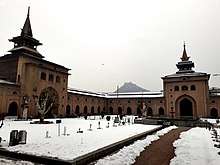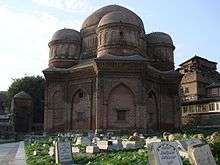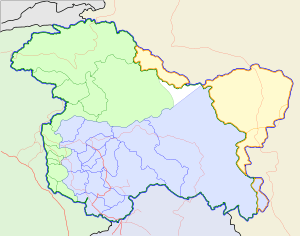Shah Mir dynasty
The Shah Mir dynasty was a dynasty that ruled the region of Kashmir in the Indian subcontinent.[1] The dynasty is named after its founder, Shah Mir. During the rule of the dynasty from 1339 to 1561, Islam was firmly established in Kashmir.
Part of a series on the |
|---|
| History of Kashmir |
|
|
|
|
|
Related articles |
| Jammu and Kashmir |
Shah Mir Sultanate | |
|---|---|
| 1339–1561 | |
| Capital | Srinagar |
| Common languages | Kashmiri, Persian |
| Religion | Islam (Sunni) |
| Government | Absolute Monarchy |
| Sultan | |
• 1339 - 1342 | Shams-ud-Din |
• 1418 - 1419 1420 - 1470 | Zain-ul-Abidin |
| History | |
• Established | 1339 |
• Disestablished | 1561 |
| Currency | Gold Dinar, Silver Dirham, Copper coin. |
Origins
The dynasty was established by Shah Mir in 1339 CE, there are two theories regarding Shah Mir's origin. Historian A. Q. Rafiqi states that some Persian chronicles of Kashmir describe Shah Mir as a descendant of the rulers of Swat.[lower-alpha 1] He thinks it more likely that he was a descendant of Turkish or Persian immigrants to Swat, who had intermarried with local indigenous peoples.[3] It has also been suggested that he belonged to a family which accompanied the sage Mir Sayyid Ali Hamadani, and who were associated to either the Kubrawiya، Sufi groups in Kashmir.[4]
On the other hand, the 15th century Kashmiri historian Jonaraja, writing in the court of Shah Mir's descendant Budshah, states that Shah Mir came to Kashmir along with his tribe from the country of Panchagahvara (identified as the Panjgabbar valley between Rajouri and Budhal). He was said to belong to the family of an ancestor called Partha, who was described as a second Partha (an allusion to the Mahabharata hero Arjuna).[5][6] Some scholars state that the Panjgabbar valley was peopled by Khasas and so ascribe a Khasa ethnicity to Shah Mir.[7][8][9]
Most modern historians accept the Swati origins of Shah Mir. Swati are Afghans came to Dir Malakand region in time of Ghaznavi. [4][10][11][12] Kashmiri scholar N. K. Zutshi, having critically examined the sources, reconciles the two versions by noting that the Persian chronicles mentions Swadgir rather than Swat, which he interprets as Swadgabar, meaning "suburbs of Gabar", which coincides with Jonaraja's description of Panchagahvara-Simani (on the borders of Panchagagvara).[13]
A. Q. Rafiqi states:
Shah Mir arrived in Kashmir in 1313 along with his family, during the reign of Suhadeva (1301–1320), whose service he entered. In subsequent years, through his tact and ability Shah Mir rose to prominence and became one of the most important personalities of his time.[14]
History
Shah Mir
Shah Mir worked to establish Islam in Kashmir and was aided by his descendant rulers, specially Sikandar Butshikan. He reigned for three years and five months from 1339–42. He was the ruler of Kashmir and the founder of the Shah Mir dynasty. He was followed by his two sons who became kings in succession.[15]
Jamshid
Sultan Shamsu'd-Din Shah was succeeded by his elder son Sultan Jamshid who ruled for a year and two months. In 1343, Sultan Jamshid suffered a defeat by his brother who ascended the throne as Sultan Alau'd-Din in 1347.[16]
Alau'd-Din
Sultan Alau'd-Din, two sons became kings in succession, Sultan Shihabu'd-Din and Sultan Qutbu'd-Din.[17]
Architecture
Some of the architectural projects commissioned by the dynasty in Kashmir include:
- Jamia Masjid in Srinagar, Jammu and Kashmir
 Jamia Masjid of Srinagar
Jamia Masjid of Srinagar - Khanqah-e-Moulah in Srinagar, Jammu and Kashmir
- Aali Masjid in Srinagar, Jammu and Kashmir
- Tomb of the Mother of Zain-ul-Abidin in Srinagar, Jammu and Kashmir
 Tomb of the Mother of Zain-ul-Abidin in Srinagar
Tomb of the Mother of Zain-ul-Abidin in Srinagar - Amburiq Mosque in Shigar, Gilgit-Baltistan
- Chaqchan Mosque in Khaplu, Gilgit-Baltistan
Reign and Successions
| Precedence | Name | AD |
|---|---|---|
| 1 | Shamsu'd-Din Shah | 1339 |
| 2 | Jamshed | 1342 |
| 3 | Ala'u'din | 1343 |
| 4 | Shihu'd-Din | 1354 |
| 5 | Qutub'd-Din | 1373 |
| 6 | Sikander | 1389 |
| 7 | Ali Shah | 1413 |
| 8 | Zainu'l'Abadin | 1420 |
| 9 | Hasan Shah | 1472 |
| 10 | Muhammad Shah (i) | 1484 |
| 11 | Fateh Shah (i) | 1486 |
| 12 | Muhammad Shah (ii) | 1493 |
| 13 | Fateh Shah (ii) | 1505 |
| 14 | Muhammad Shah (iii) | 1514 |
| 15 | Fateh Shah (ii1) | 1515 |
| 16 | Muhammad Shah (iv) | 1517 |
| 17 | Ibrahim Shah (i) | 1528 |
| 18 | Nazuk Shah (i) | 1529 |
| 19 | Muhammad Shah (v) | 1530 |
| 20 | Shamsu'd-Din (ii) | 1537 |
| 21 | Ismail Shah (i) | 1540 |
| 17 | Nazuk Shah (ii) (i) | 1540 |
| 18 | Ibrahim Shah (i) | 1552 |
| 19 | Ismail Shah (ii) (v) | 1555 |
| 20 | Habib Shah | 1557–1561 |
Note: Muhammad Shah had five separate reigns from 1484 to 1537.[19]
See also
- Sikandar Butshikan
- Zain-ul-Abidin
- Mir Sayyid Ali Hamadani
- List of Sunni Muslim dynasties
Notes
- Unreliable Sources - The chronicles include those of Tahir, Haidar Malik, Rafiu'd Din Ahmad and Muhammad A'azam.[2]
References
- Sharma, R. S. (1992), A Comprehensive History of India, Orient Longmans, p. 628, ISBN 978-81-7007-121-1
- Gull, Surayia (2003), Mir Saiyid Ali Hamadani And Kubraviya Sufi Order In Kashmir, Kanikshka Publishers, Distributors, p. 3, ISBN 978-81-7391-581-9
- Baloch & Rafiq 1998, pp. 311-312.
- Schimmel 1980, p. 44.
-
Sharma, R. S. (1992), A Comprehensive History of India, Orient Longmans, p. 628, ISBN 978-81-7007-121-1,
Jonaraja records two events of Suhadeva's reign (1301-20), which were of far-reaching importance and virtually changed the course of the history of Kashmir. The first was the arrival of Shah Mir in 1313. He was a Muslim condottiere from the border of Panchagahvara, an area situated to the south of the Divasar pargana in the valley of river Ans, a tributary of the Chenab.
- Zutshi, N. K. (1976), Sultan Zain-ul-Abidin of Kashmir: an age of enlightenment, Nupur Prakashan, pp. 6–7
-
Wani, Nizam-ud-Din (1987), Muslim rule in Kashmir, 1554 A.D. to 1586 A.D., Jay Kay Book House, p. 29,
Shamir was a Khasa by birth and descended from the chiefs of Panchagahvara.
-
Saxena, Savitri (1995), Geographical Survey of the Purāṇas: The Purāṇas, a Geographical Survey, Nag Publishers, pp. 360–361, ISBN 978-81-7081-333-0,
In the Rajatarangini, the rulers of Rajapuri (modern Rajauri) are called the lord of Khasas and their troops as Khasas. They occupied the valleys of Ans river, now called Panjagabhar (Pancagahvara of Srivara IV 213).
-
Zutshi, N. K. (1976), Sultan Zain-ul-Abidin of Kashmir: an age of enlightenment, Nupur Prakashan, p. 7,
"This area in which Panchagahvara was situated is mentioned as having been the place of habitation of the Khasa tribe. Shah Mir was, therefore, a Khasa by birth. This conclusion is further strengthened by references to the part of the Khasas increasingly played in the politics of Kashmir with which their connections became intimate after the occupation of Kashmir.
- Wink 2004, p. 140"The first Muslim dynasty of Kashmir was founded in 1324 by Shah Mìrzà, who was probably an Afghan warrior from Swat or a Qarauna Turk, possibly even a Tibetan..."
- Gupta, Jyoti Bhusan Das (6 December 2012), Jammu and Kashmir, Springer, pp. 19–, ISBN 978-94-011-9231-6
- Snedden, Christopher (2015), Understanding Kashmir and Kashmiris, Oxford University Press, pp. 28–, ISBN 978-1-84904-342-7
- Zutshi, N. K. (1976), Sultan Zain-ul-Abidin of Kashmir: an age of enlightenment, Nupur Prakashan, p. 7
- Baloch & Rafiq 1998, p. 312.
- Baharistan-i-Shahi – Chapter 3 – EARLY SHAHMIRS
- Baharistan-i-Shahi – Chapter 3 – EARLY SHAHMIRS
- Baharistan-i-Shahi – Chapter 3 – EARLY SHAHMIRS
- Hasan, Mohibbul (2005) [1959]. Kashmir Under the Sultans (Reprinted ed.). Delhi: Aakar Books. p. 325. ISBN 978-81-87879-49-7. Retrieved 17 January 2013.
- http://coinindia.com/galleries-kashmirsultans.html
